Applied Mechanics and Design - Online Test
Q1. A pin jointed uniform rigid rod of weight W and Length L is supported horizontally
by an external force F as shown in the figure below. The force F is suddenly
removed. At the instant of force removal, the magnitude of vertical reaction
developed at the support is 

Answer : Option B
Explaination / Solution:
No Explaination.
Q2. In a CAD package, mirror image of a 2D point P(5, 10) is to be obtained about a
line which passes through the origin and makes an angle of 45° counterlockwise
with the X-axis. The coordinates of the transformed point will be
Answer : Option B
Explaination / Solution:
No Explaination.
Q3. A bar is subjected to fluctuating tensile load from 20 kN to 100 kN. The material
has yield strength of 240 MPa and endurance limit in reversed bending is 160
MPa. According to the Soderberg principle, the area of cross-section in mm2 of
the bar for a factor of safety of 2 is
Answer : Option D
Explaination / Solution:
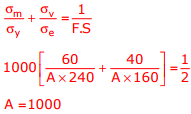

Q4. A simply supported beam of length L is subjected to a varying distributed load  where the distance x is measured from the left support. The
magnitude of the vertical force in N at the left support is
where the distance x is measured from the left support. The
magnitude of the vertical force in N at the left support is
 where the distance x is measured from the left support. The
magnitude of the vertical force in N at the left support is
where the distance x is measured from the left support. The
magnitude of the vertical force in N at the left support is
Answer : Option B
Explaination / Solution:
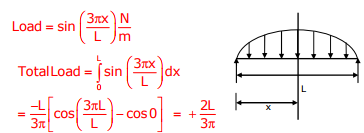


Since the load is distributed equally on both supports

Q5. A single riveted lap joint of two similar plates as shown in the figure below has
the following geometrical and material details: 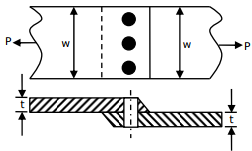

Width of the plate w=200 mm, thickness of the plate t=5 mm, number of rivets
n=3, diameter of the rivet dr = 10mm, diameter of the rivet hole dh = 11mm, allowable tensile stress of the plate σp = 200 MPa, allowable shear stress of the
rivet σs = 100 MPa and allowable bearing stress of the σc = 150 MPa
If the rivets are to be designed to avoid crushing failure, the maximum
permissible load P in kN is
Answer : Option C
Explaination / Solution:
No Explaination.
Q6. A single riveted lap joint of two similar plates as shown in the figure below has the following geometrical and material details: 

Width of the plate w=200 mm, thickness of the plate t=5 mm, number of rivets n=3, diameter of the rivet dr = 10mm, diameter of the rivet hole dh = 11mm, allowable tensile stress of the plate σp = 200 MPa, allowable shear stress of the rivet σs = 100 MPa and allowable bearing stress of the σc = 150 MPa
If the plates are to be designed to avoid tearing failure, the maximum
permissible load P in kN is
Answer : Option C
Explaination / Solution:
No Explaination.
Q7. In orthogonal turning of a bar of 100 mm diameter with a feed of 0.25 mm/rev,
depth of cut of 4 mm and cutting velocity of 90 m/min, it is observed that the
main (tangential) cutting force is perpendicular to the friction force acting at the
chip-tool interface. The main (tangential) cutting force is 1500 N.
The orthogonal rake angle of the cutting tool in degree is
Answer : Option A
Explaination / Solution:
No Explaination.
Q8. A rod of length L having uniform cross-sectional area A is subjected to a tensile
force P as shown in the figure below. If the Young’s modulus of the material
varies linearly from E1 to E2 along the length of the rod, the normal stress
developed at the section-SS is
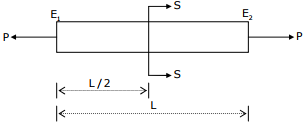

Answer : Option A
Explaination / Solution:
Stress depends on area.
Q9. A block weighing 981 N is resting on a horizontal surface. The coefficient of friction between the
block and the horizontal surface is μ = 0.2. A vertical cable attached to the block provides partial
support as shown. A man can pull horizontally with a force of 100N. What will be the tension, T (in
N) in the cable if the man is just able to move the block to the right?
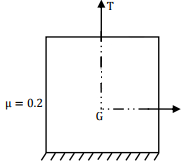

Answer : Option C
Explaination / Solution:
No Explaination.
Q10. If the principal stresses in a plane stress problem, are σ1 = 100MPa, σ2 = 40MPa the magnitude
of the maximum shear stress (in MPa) will be
Answer : Option C
Explaination / Solution:
No Explaination.
